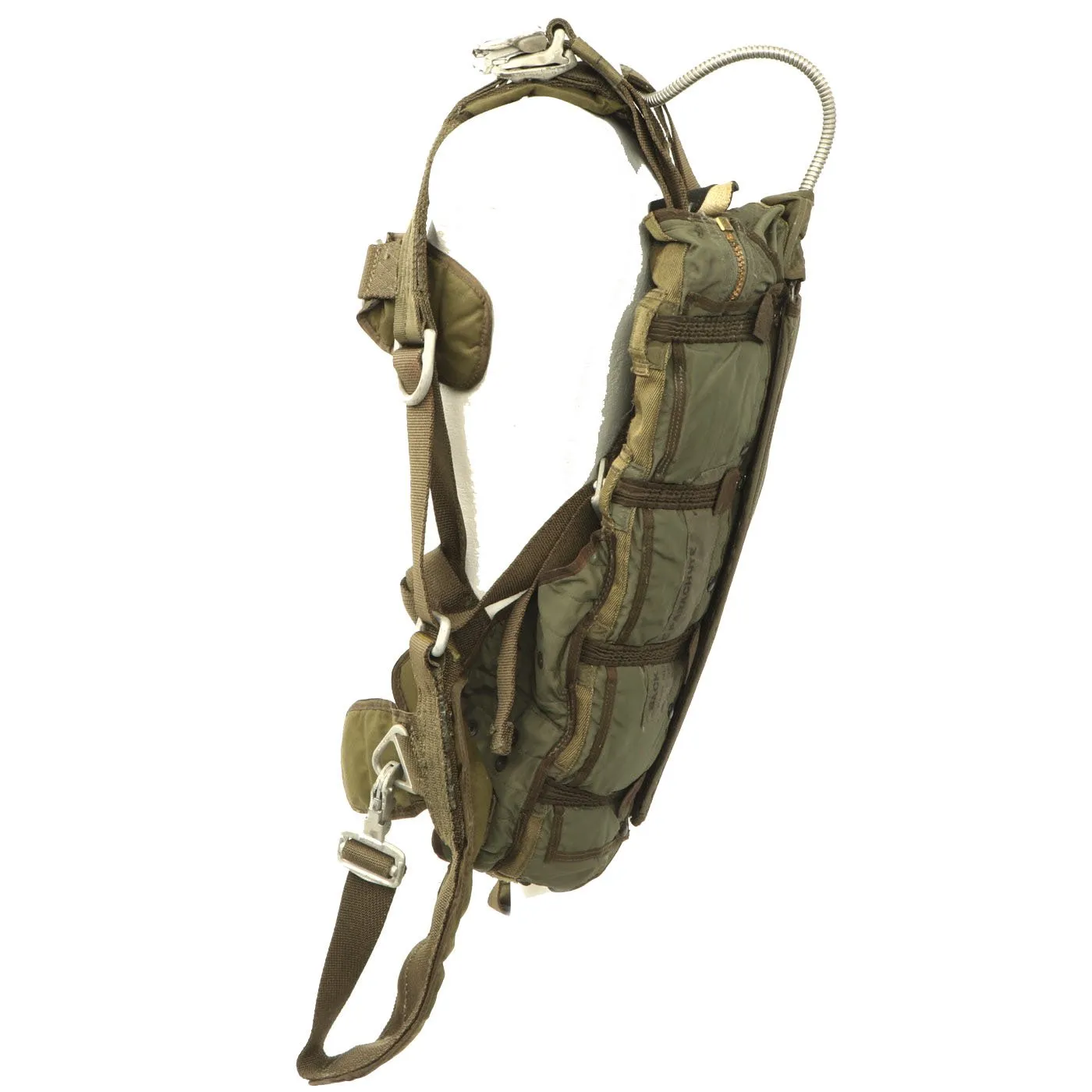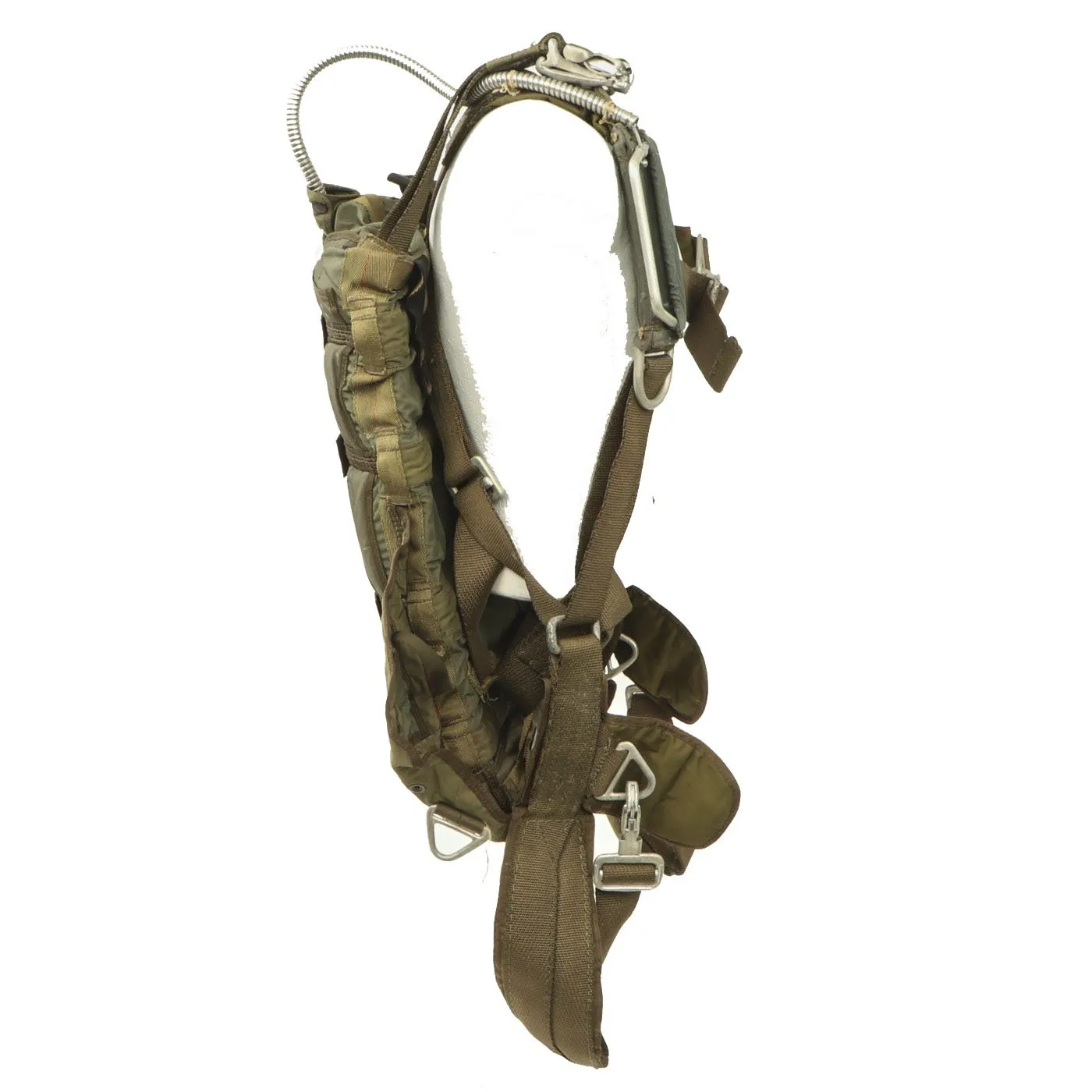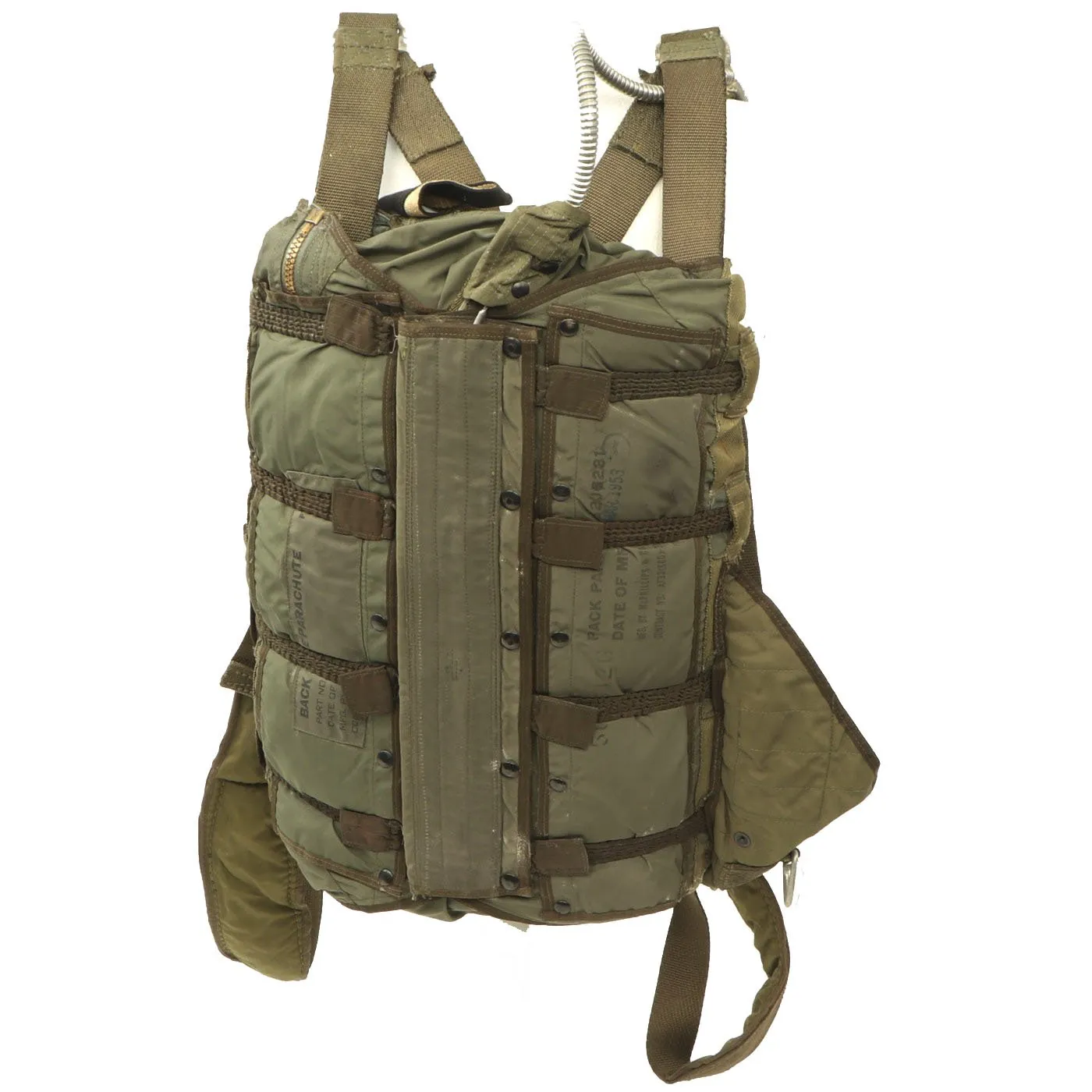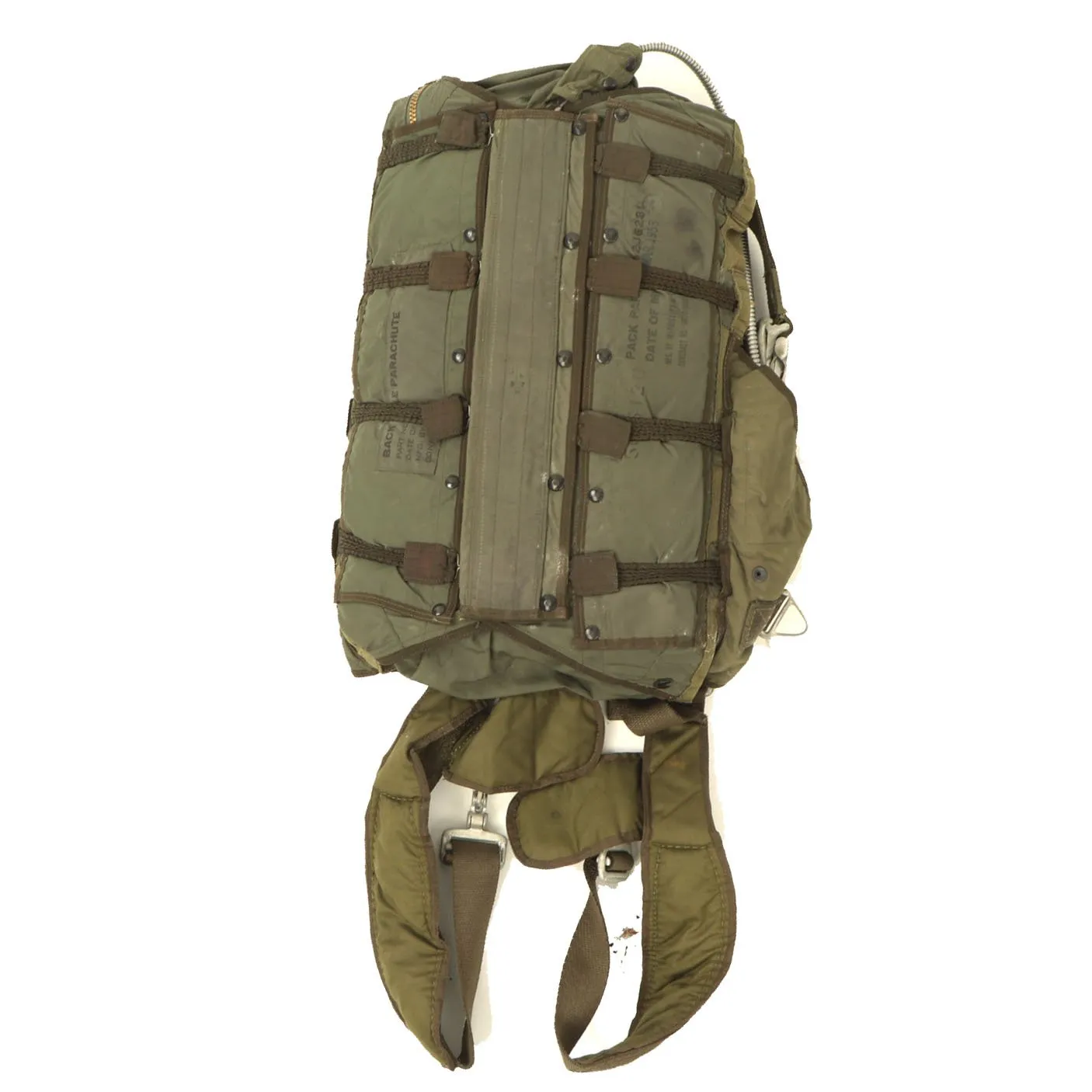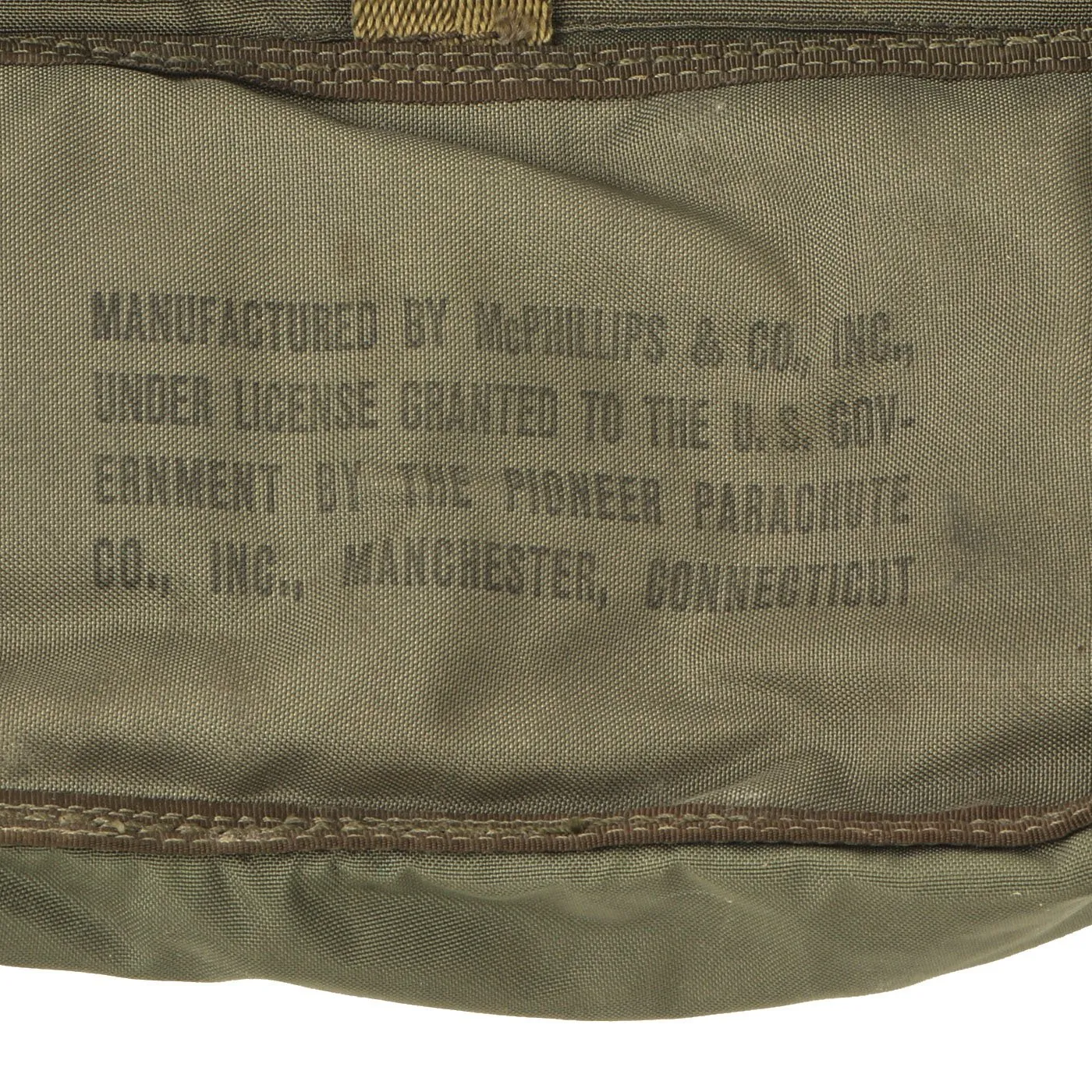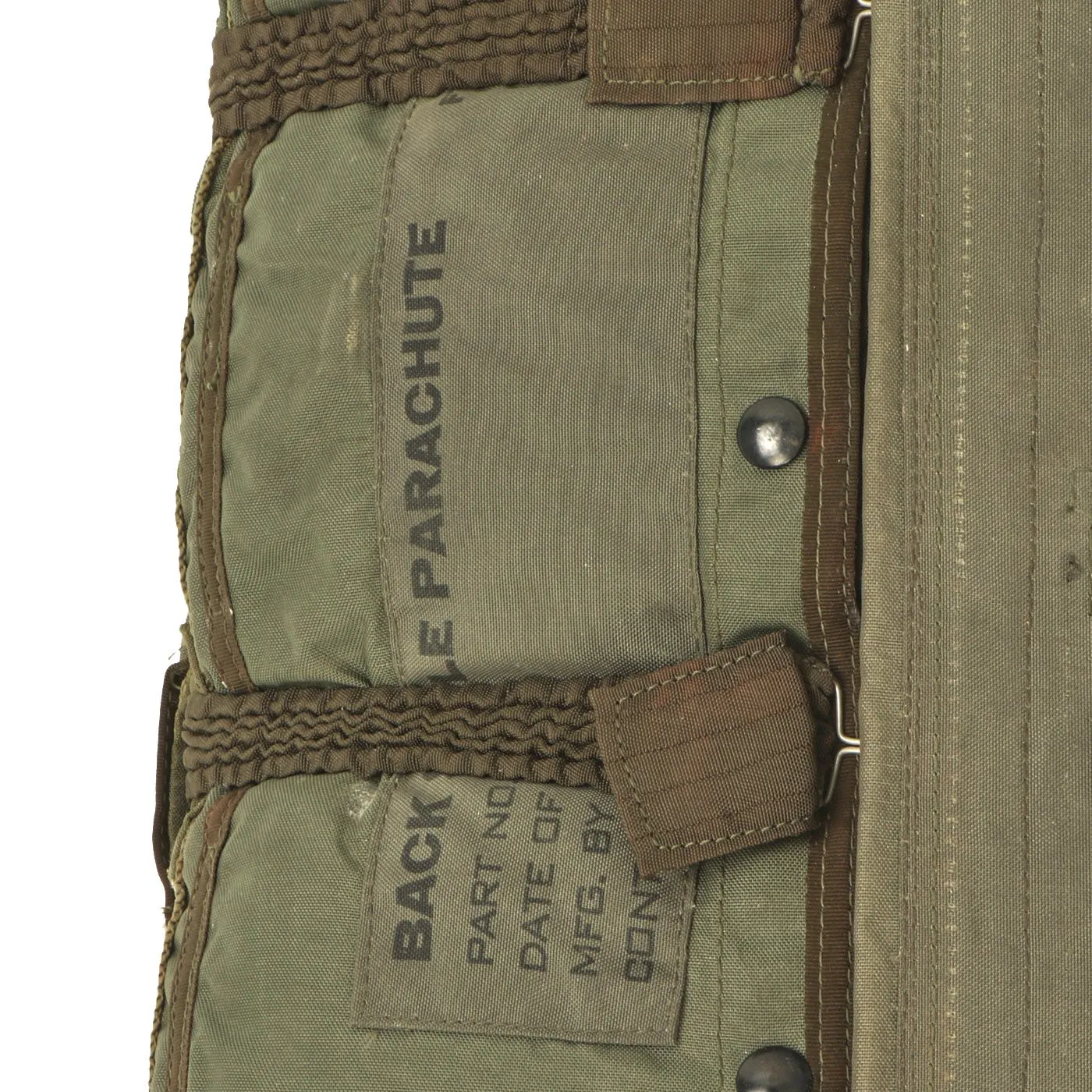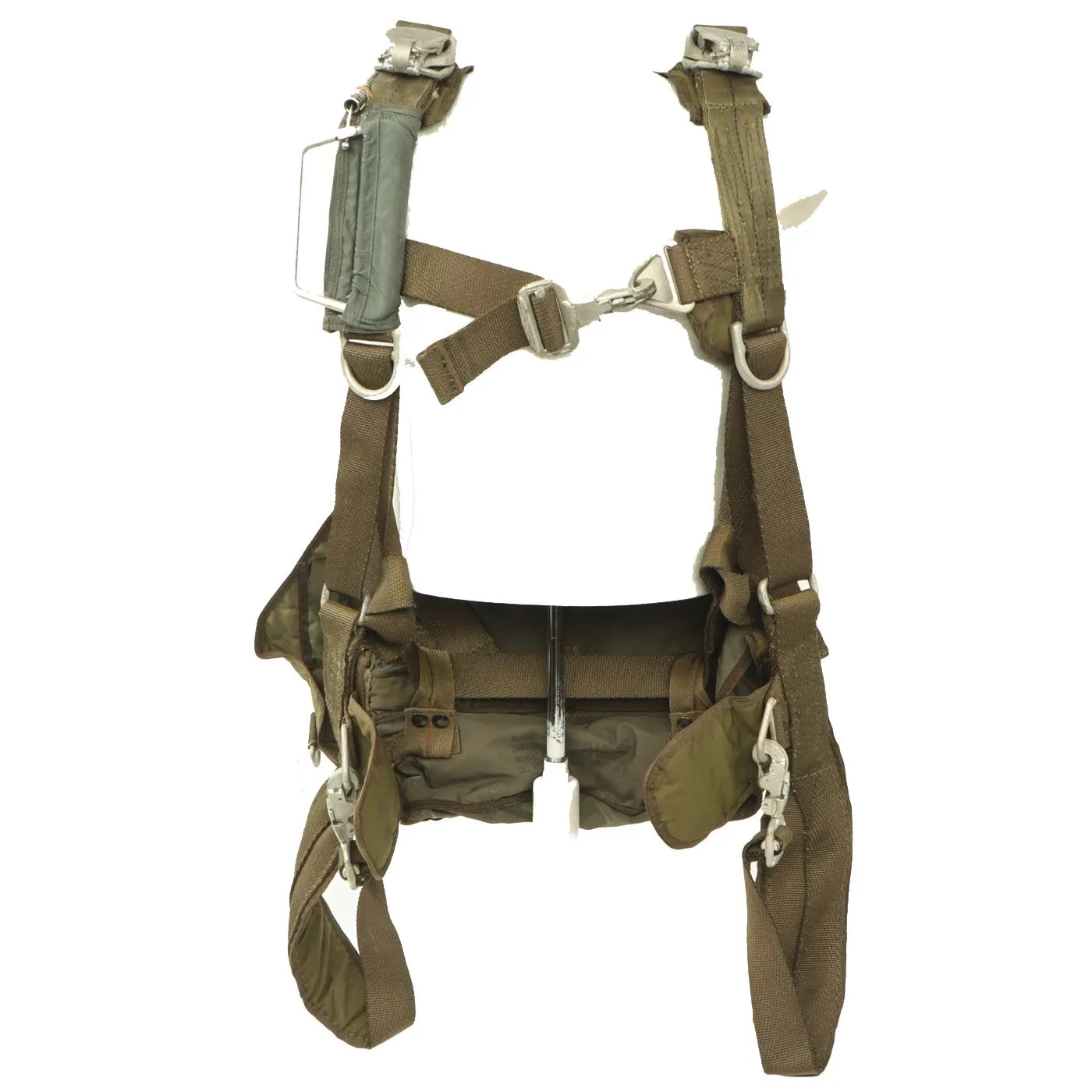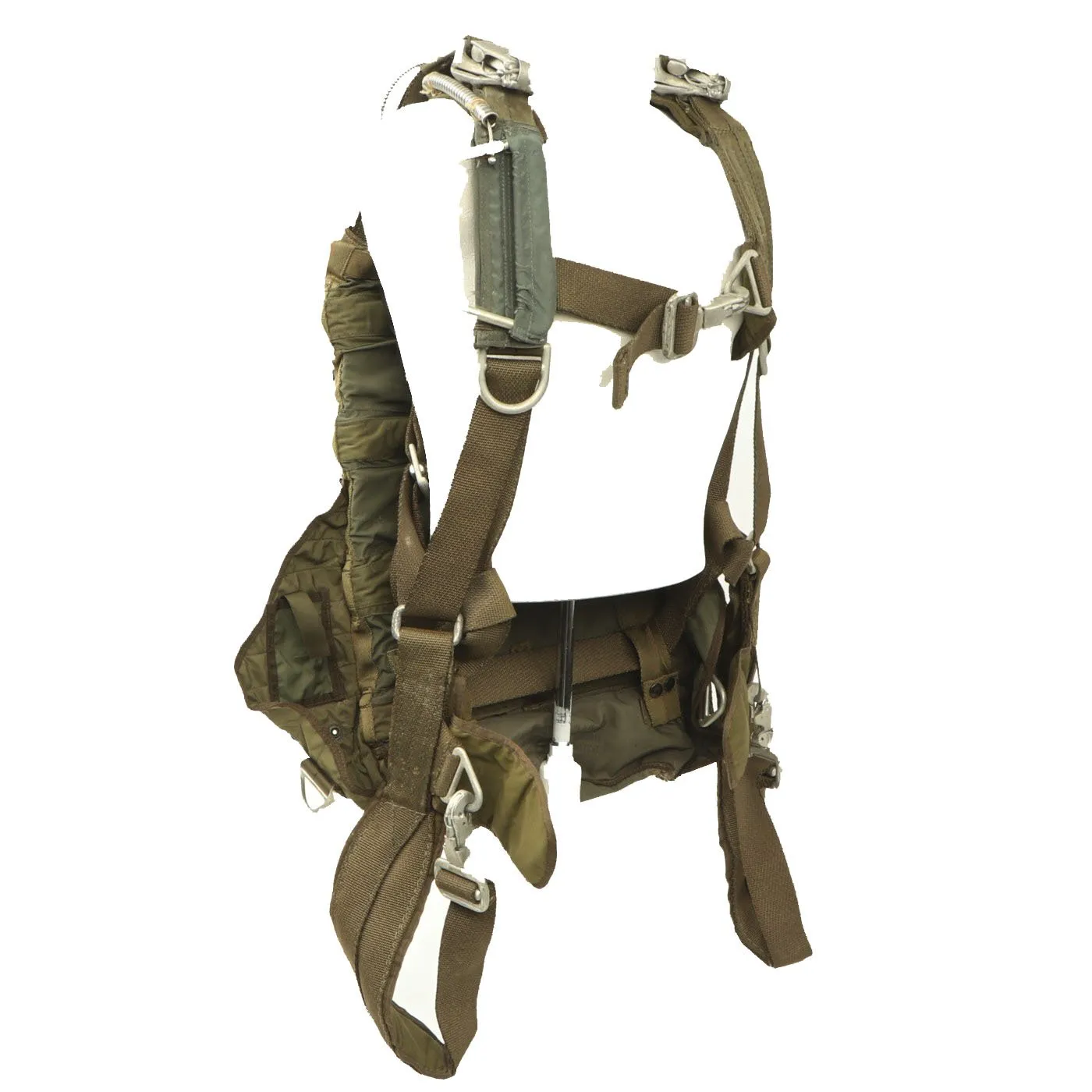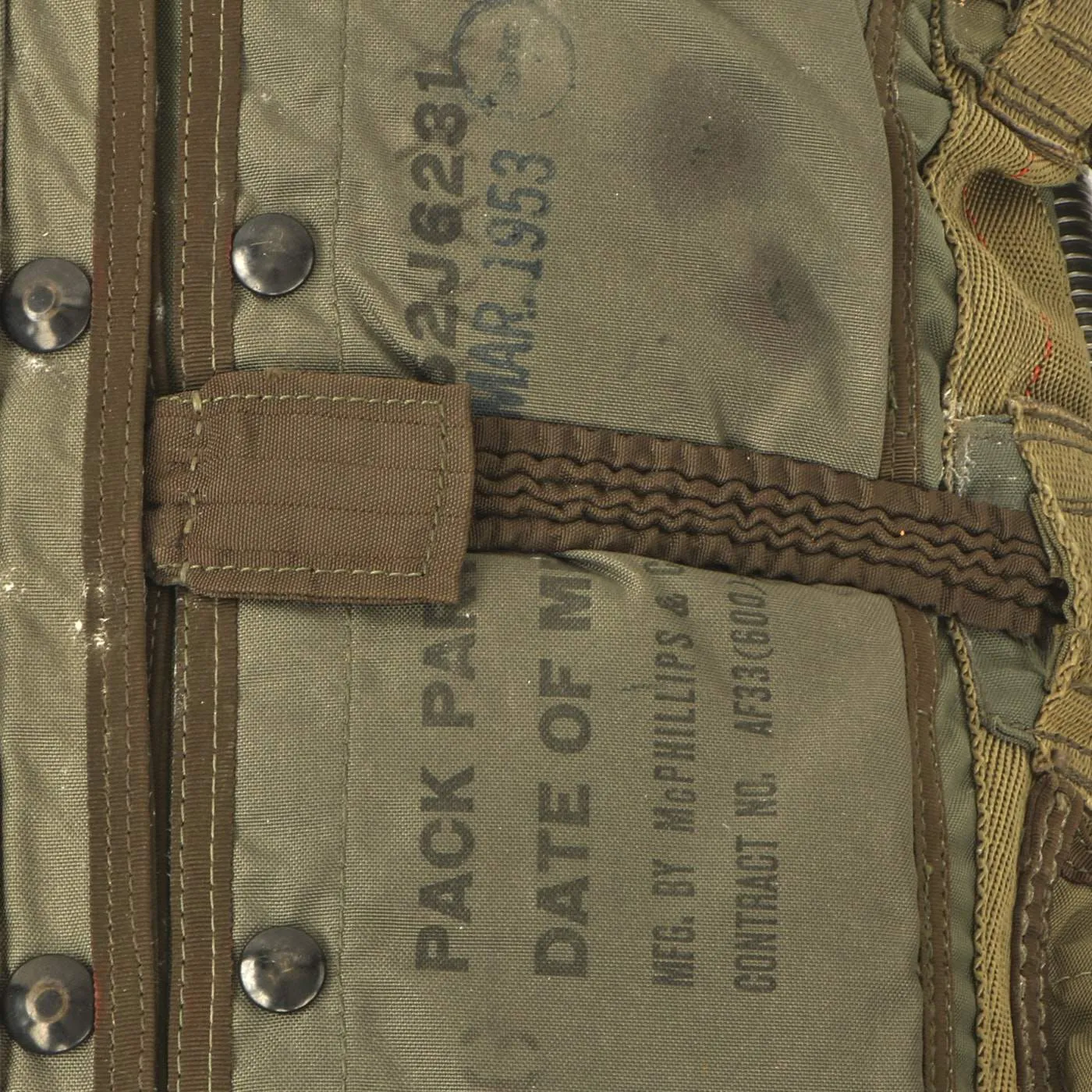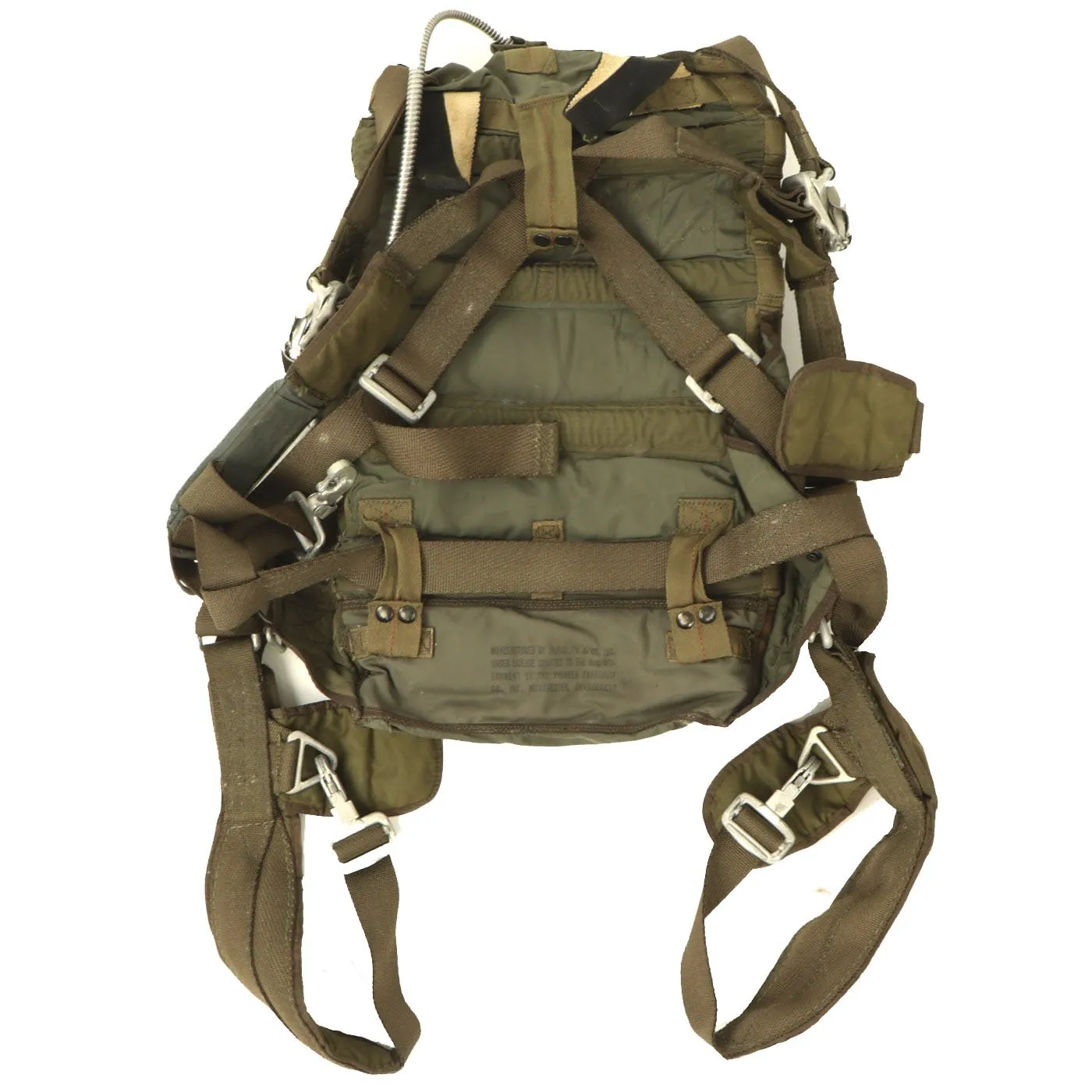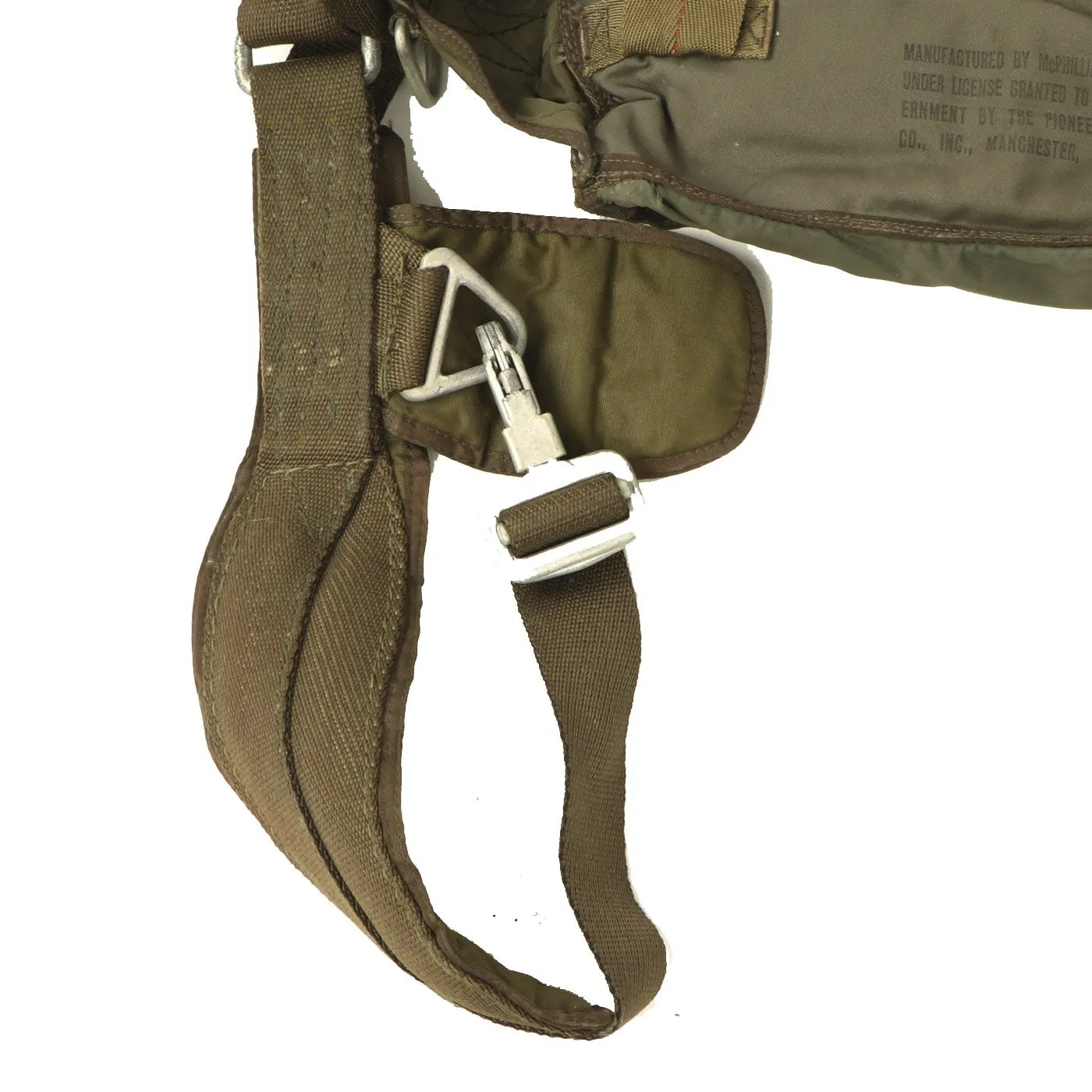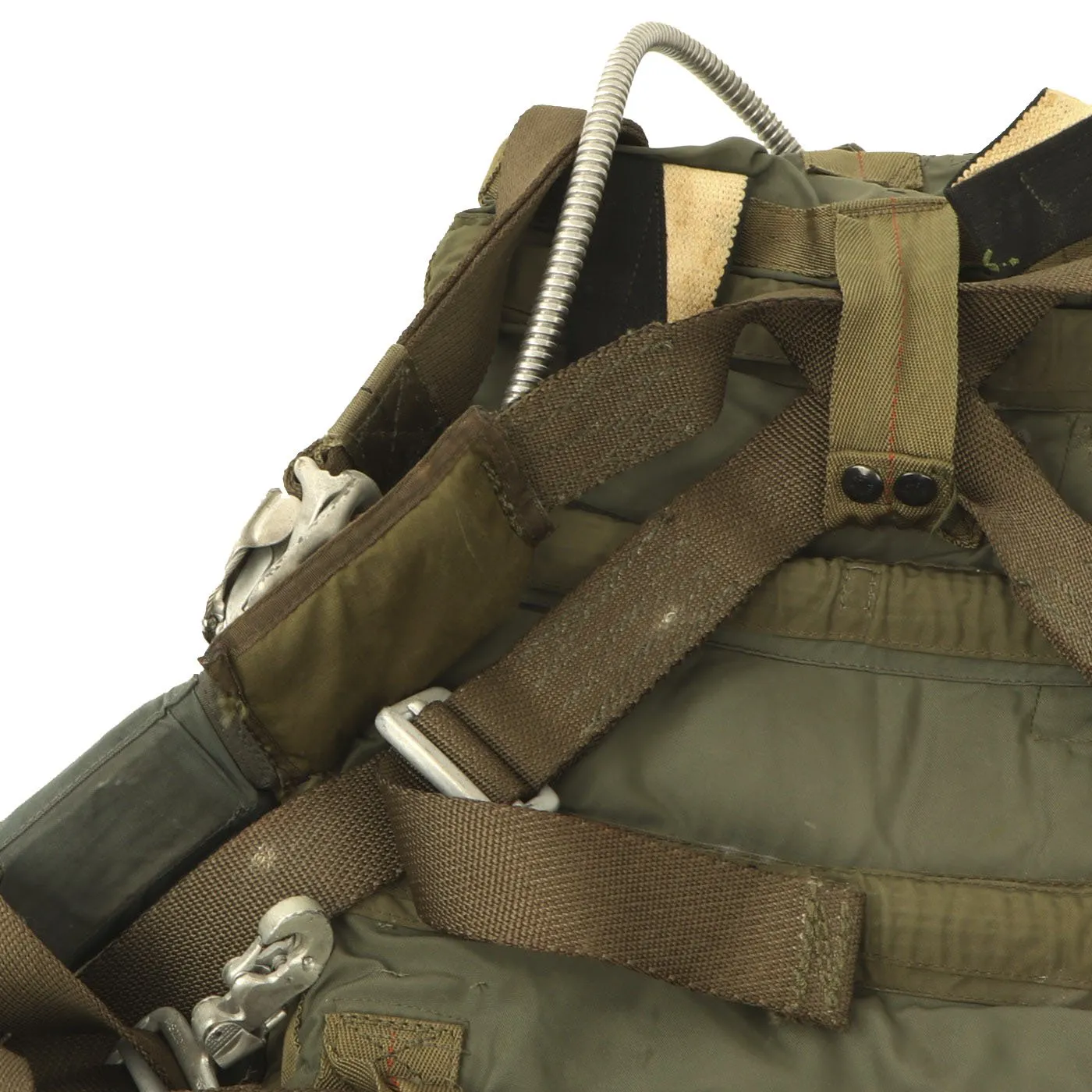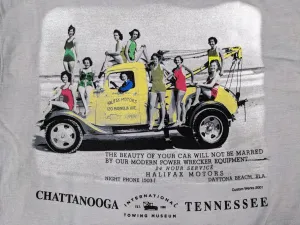Original Item: Only One Available. Pack Part number 52J6231 dated March 1953 complete with harness but no canopy is included.
USAF parachute types in use in Korea, Vietnam, and into the 70s are complex due to the fact that official US military nomenclature changed many times with regard to parachute components since the 1930s. Formerly, each of the three components comprising a complete chute assembly was type classified (that is, there was a discrete harness designation, a discrete pack designation, and a discrete canopy designation). Some confusion results today in the mistaken substitution of the harness designation for the complete chute assembly, when in fact the practice of referring to a completely integrated chute assembly did not take place until the newer BA (Back Automatic) series of chutes were designated in the late 50s. As for harness types, many will notice that aside from Capewell variations (older and newer styles), in some photographs taken of pilot gear in the 50s, 60, and 70s, the chutes worn have: 1) two (bilateral) riser canopy older style Capewell releases; 2) a single left side modern Capewell release; or 3) bilateral (one on each side) modern Capewell releases. (The newer style Capewell release is also referred to by LSETs as the "Two-ball Release", a reference to the two steel locator balls integrated onto the cable component of the release.) The differences in harness types can be best illustrated by reverting to a review of the categorization nomenclature of harness types.
As of 1954, USAF Chute harnesses were categorized as Class I, Class II, Class III, or Class IV. Class I harnesses were old style, WWII types harnesses that did not have quick release riser Capewells. They used what are called "connector Links" and/or "3-bar Shoulder Adaptors", as the risers were themselves integral parts of the harness assembly. By 1954 (AFM 64-4 Oct 1954) the Class I harness was no longer actively being acquired, although they remained in limited service (particularly with older seat-style chutes). Class II harnesses used the old style Irvin modified British "Bang-Box" quick release chest connector; they also, had no separate riser straps and the risers used the same style "connector links" or "3-bar Shoulder Adaptors" as did the Class I harnesses. Both the Class I and Class II harnesses were at that time (1954) being replaced by the newer Class III harnesses.
The Class III harness, a newer type, had twin bilateral old-style Capewell releases and used separate riser assemblies that could both be detached quickly, cutting the chute canopy away, so as to prevent an airman being fouled in his canopy upon landing (in water, this posed a particularly severe hazard).
The newer, or Class IV harness, featured a somewhat simplified and integrated harness/pack approach to its design, and as of 1959 this harness design was adopted as the standard USAF back-style parachute harness. The designation B-5 was assigned initially to this new style assembly, which featured self-adjusting mainsling straps and an integrated "vest" to which the straps were attached for ease of donning and fitment.
In 1954 the standard USAF back-style manual (no automatic release) chute was referred to as the Parachute Assembly, Back, PN 50C7024-7 and 50C7024-B. This chute was essentially a WWII style pack container attached (integrally mated) to a Class III harness, fitted with twin old style Capewell riser releases. The standard USAF automatic opening back style chute was referred to as the Parachute Assembly, Back Automatic PN 50C7024-9 and 50C7024-10. The other standard back style chute, known as the B-8, was somewhat similar to the manual and automatic chutes described above in appearance, but was generally not equipped with the F-1 or F-1A Automatic Ripcord Release assembly. Some color variation in these chutes' packs were noticeable, with older B-8 style chutes frequently being seen in dark or light khaki color nylon. OD color nylon was more predominant in the immediate post Korean War period, although the newer sage green color nylon became the standard in about 1955-56.
In about 1959, it was determined by the Aeronautical Systems Division at WPAFB, in concert with ARDC assessments of personal equipment in use, that it would be preferable to change the Class III harness system so as to provide only a single left sided Capewell riser release. This was to assure that the canopy would not be lost altogether on landing, given its frequent importance as a survival item. With twin bilateral releases, the canopy could fly away or be lost, since it would then become entirely free from the harness. As is frequently the case, however, experience in the field with this system, in use for several years in the late 50s and early 60s until the B-5 system came into full standard production, showed that a return to the twin riser released system was actually the better concept. This 'wisdom' was proven in Vietnam, when downed pilots frequently found it necessary to quickly disengage from the parachute canopy so as to facilitate rapid escape & evasion. Thus, the later versions of the new B-5 type chute assembly featured twin bilateral "Two-ball" Capewell releases, instead of simply one on the left side as the first B-5 type chute were equipped with. Older B-5 chutes were updated to comply with the final twin-release B-5 type harness mandates.
Of interest is the fact that at about this time, in the late 50s, after so many years of relatively little change in aircrew personal equipment items (with the exception of helmet developments), new demands mandated by the operating requirements of the high-performance jet-engined aircraft that were just coming on line prompted an overhaul of the old "Personal Equipment" specialty and accordingly served to stimulate reorganisation of what was formerly "Personal Equipment" into a greatly expanded "Aircrew Life Support Equipment" AFSC. Prior to that time, the typical Personal Equipment Officer, who had charge of his squadron's gear and its maintenance, was fulfilling this function as an 'extra duty' assignment. Depending upon his enthusiasm for an interest in personal equipment items and their maintenance, the squadron's equipment was either well looked-after or perfunctorily checked. Thereafter, the Personal Equipment Officer became a dedicated Life Support Equipment Officer (with a formal officer career area) and a greatly substantially expanded aviation enlisted career field of technical life support specialists came into being.
In about 1960-61, new nomenclature was adopted for USAF back-style chutes, resulting in the B-5 type chute, equipped with the F-1A/B Automatic Ripcord Release apparatus, being termed the BA-XX. The BA-18,22, and 24 chutes were all successive developments of the B-5 type chute (with Class IV harness) used in the Century Series fighters; these chutes required closer integration with the more highly evolved aircraft emergency egress (ejection seat) systems then being developed and installed, and technical maintenance of chutes became far more exacting and carefully regulated. The BA-24, for example, used a ballistically deployed pilot chute actuation system that was integrated into the F-105 and F-106 aircraft ejection seats. The standard USAF Seat-type chute used in such aircraft as the T-33 Thunderbird (which required such chute types) was designated the SA-17 chute assembly (Seat Automatic).
Canopies used with USAF chutes were predominantly the C-8, C-9, C-10, and C-11. The C-8 and C-9 were manufactured of nylon and had alternating orange and white panels in the late 50s; they were flat circular canopies measuring 28 feet diameter. The C-10 and C-11 canopies were of a specially modified gore design for high-speed use, and were slightly smaller in diameter (24 feet). Effectively speaking, however, due to dynamic design considerations, nominal diameter for both canopies were about equal to each other in effectiveness.
Nylon had been first used to replace silk canopies in US Army Air Force chutes in about 1944-45, and after that date no other material was used other than nylon. The basic nylon canopy material was further improved in the late 60s by making it in the "rip-stop" style, with stronger reinforcing threads run in a cross-hatch pattern through the material. The first use of alternating color panels for high visibility took place in the Second World War, when red and white panel designs were first used to help in recovery efforts. The camouflaged canopy (OD) also was developed in that period, although much later (Vietnam) multi-colored camouflage was in use instead of OD colored panels. In Vietnam, the bright orange and white C-9 colored canopies were not used for obvious purposes; instead a camouflage design aided downed fliers in escape and evasion, once landed safely. The high-speed C-10 and C-11 chute canopies were used with quarter deployment bags to lessen the shock of opening at high speed; this was a sleeve device that upon deployment released the main chute slowly to reduce the threat of shredding from windblast. Steerable gores allowed some directional control over the chutes to enable pilots to avoid landing in unfavorable locales.
One final note on USAF chutes. The original D-ring ripcord release handle originally used on chutes for many decades was frequently found to pull loose inadvertently out of its securing pocket. This persistent problem was corrected somewhat in the mid to late 50s by installation of a modified tubular "T" shaped ripcord release handle. The "T" handle was in turn replaced by what is described by riggers and LSETs as the "Blast Handle". The Blast Handle was a cast aluminum metal piece with two diagonally slanted, knurled flanges; the assembly was gripped in both hands and pulled downward with a firm motion. The Blast Handle unfortunately was found to be less than ideal in actual use and the last ripcord handle used on USAF chutes was the older "T" handle design. Most BA-18, 22, and 24 chutes were originally fitted with the Blast Handle in the 60s period.




